FDM Layering Deposition Effects on Mechanical Response of TPU Lattice Structures
Abstract
:1. Introduction
2. Fused Deposition Modeling on Lattice Structures
2.1. Design
2.2. Experimental Tests
2.3. FDM Process in Conjunction with TPU
3. Finite Element Method on Lattice Structures
3.1. Material: Models
3.2. Simulations and Overviews
4. Results
5. Discussion
6. Conclusions
- By the traditional FE analysis, an anisotropic behavior of such structures was proven;
- Anisotropy was ascribed to the layering process of filament, not always quantifiable a priori;
- A phenomenological layering factor φl was defined that tries to correlate the number of FDM contours, the deformation level, with the anisotropy degree;
- On the basis of the layering factor, thin-walled cell structures were confirmed to be the less affected, whereas larger walled structures were negatively affected;
- The mechanical and functional behaviors of this kind of structure were confirmed to be influenced by many parameters, related to material and process, as well asa specific geometry.
Author Contributions
Funding
Institutional Review Board Statement
Informed Consent Statement
Data Availability Statement
Acknowledgments
Conflicts of Interest
References
- Wang, P.; Zou, B.; Ding, S.; Li, L.; Huang, C. Effects of FDM-3D printing parameters on mechanical properties and microstructure of CF/PEEK and GF/PEEK. Chin. J. Aeronaut. 2021, 34, 236–246. [Google Scholar] [CrossRef]
- Ziemian, C.; Sharma, M.; Ziemian, S. Anisotropic mechanical properties of ABS parts fabricated by fused deposition modelling. In Mechanical Engineer; Gokcek, M., Ed.; InTech: London, UK, 2017; pp. 159–180. [Google Scholar]
- Durgun, I.; Ertan, R. Experimental investigation of FDM process for improvement of mechanical properties and production cost. Rapid Prot. J. 2014, 20, 228–235. [Google Scholar] [CrossRef]
- Pagac, M.; Schwarz, D.; Petru, J.; Polzer, S. 3D printed polyurethane exhibits isotropic elastic behavior despite its anisotropic surface. Rapid Prot. J. 2020, 26. [Google Scholar] [CrossRef]
- Garzon-Hernandez, S.; Garcia-Gonzalez, D.; Jérusalem, A.; Arias, A. Design of FDM 3D printed polymers: An experimental-modelling methodology for the prediction of mechanical properties. Mater. Des. 2020, 188, 108414. [Google Scholar] [CrossRef]
- Ahn, S.H.; Montero, M.; Odell, D.; Roundy, S.; Wright, P.K. Anisotropic material properties of fused deposition modeling ABS. Rapid Prot. J. 2002, 8, 248–257. [Google Scholar] [CrossRef] [Green Version]
- Baich, L.; Manogharan, G.; Marie, H. Study of infill print parameters on mechanical strength and production cost-time of 3D printed ABS parts. Int. J. Rapid Manuf. 2015, 5, 308–319. [Google Scholar] [CrossRef]
- Bhate, D.; Penick, C.A.; Ferry, L.A.; Lee, C. Classification and selection of cellular materials in mechanical design: Engineering and biomimetic approaches. Designs 2019, 3, 19. [Google Scholar] [CrossRef] [Green Version]
- Kumar, A.; Verma, S.; Jeng, J.-Y. Supportless Lattice structures for energy absorption fabricated by fused deposition modeling. 3D Print. Add. Manuf. 2020, 7, 85–96. [Google Scholar] [CrossRef]
- Askari, M.; Hutchins, D.A.; Thomas, P.J.L.; Astolfi, R.L.; Watson, M.; Abdi, M.; Ricci, S.; Laureti, L.; Nie, S.; Freear, R.; et al. Additive manufacturing of metamaterials: A. review. Add. Manuf. 2020, 36, 101562. [Google Scholar] [CrossRef]
- Nazir, A.; Abate, K.M.; Kumar, A.; Jeng, J.-Y. A state-of-the-art review on types, design, optimization, and additive manufacturing of cellular structures. Int. J. Adv. Manuf. Technol. 2019, 104, 3489–3510. [Google Scholar] [CrossRef]
- Bartolomé, L.; Aginagalde, A.; Martínez, A.B.; Urchegui, M.A.; Tato, W. Experimental characterization and modelling of large-strain viscoelastic behavior of a thermoplastic polyurethane elastomer. Rubber Chem. Technol. 2013, 86, 146–164. [Google Scholar] [CrossRef]
- Solomon, I.J.; Sevvel, P.; Gunasekaran, J. A review on the various processing parameters in FDM. Mater. Today Proc. 2021, 37, 509–514. [Google Scholar] [CrossRef]
- Panda, B.; Leite, M.; Biswal, B.B.; Niu, X.; Garg, A. Experimental and numerical modelling of mechanical properties of 3D printed honeycomb structures. Measurement 2018, 116, 495–506. [Google Scholar] [CrossRef]
- Sood, A.K.; Ohdar, R.K.; Mahapatra, S.S. Experimental investigation and empirical modeling of FDM process for compressive strength improvement. J. Adv. Res. 2012, 3, 81–90. [Google Scholar] [CrossRef] [Green Version]
- Wu, W.; Geng, P.; Li, G.; Zhao, D.; Zhang, H.; Zhao, J. Influence of layer thickness and raster angle on the mechanical study between PEEK and ABS. Materials 2015, 8, 5834–5846. [Google Scholar] [CrossRef]
- Hernandez, R.; Slaughter, D.; Whaley, D.; Tate, J.; Asiabanpuor, B. Analyzing the tensile, compressive, and flexural properties of 3D printed ABS parts. In Proceedings of the 27th Annual International Solid Freeform Fabrication Symposium, San Marcos, TX, USA, 8–10 August 2016; pp. 939–950. [Google Scholar]
- Motaparti, K.P. Effect of Build Parameters on Mechanical Properties of Ultem 9085 Parts by Fused Deposition Modeling. Masters’ Thesis, Missouri University of Science and Technology, Rolla, MO, USA, 2016. [Google Scholar]
- Vega, V.; Clements, J.; Lam, T.; Abad, A.; Fritz, B.; Ula, N.; Es-Said, O.S. The effect of layer orientation on the mechanical properties and microstructure of a polymer. J. Mater. Eng. Perform. 2011, 20, 978–988. [Google Scholar] [CrossRef]
- Mohaed, O.A.; Masood, S.H.; Bhowmik, J.L. Optimization of FDM process parameters: A review of current research and future prospects. Adv. Manuf. 2015, 3, 42–52. [Google Scholar] [CrossRef]
- Torrado, A.R.; Shemelya, C.M.; English, J.D.; Lin, Y.; Wicker, R.B.; Roberson, D.A. Characterizing the effect of additives to ABS on the echanical property anisotropy of specimens fabricated by material extrusion 3D printing. Add. Manuf. 2015, 6, 16–29. [Google Scholar]
- Dawoud, M.; Taha, I.; Ebeid, S.J. Mechanical behaviour of ABS: An experimental study using FDM and injection moulding techniques. J. Manuf. Process. 2016, 21, 39–45. [Google Scholar] [CrossRef]
- Hmeidat, N.S.; Pack, R.C.; Talley, S.J.; Moore, R.B.; Compton, B.G. Mechanical anisotropy in polymer composites produced by material extrusion additive manufacturing. Add. Manuf. 2020, 34, 101385. [Google Scholar] [CrossRef]
- Rybachuk, M.; Mauger, C.A.; Fiedler, T.; Öchsner, A. Ochsner, Anisotropic mechanical properties of fused deposition modeled parts fabricated by using acrylonitrile butadiene styrene polymer. J. Polym. Eng. 2017, 37, 699–706. [Google Scholar] [CrossRef]
- Anitha, R.; Arunachalam, S.; Radhakrishnan, P. Critical parameters influencing the quality of prototypes in fused deposition modelling. J. Mater. Proc. Technol. 2001, 118, 385–388. [Google Scholar] [CrossRef]
- Rodríguez-Panes, A.; Claver, J.; Camacho, A.M. The influence of Manufacturing parameters on the mechanical behaviour of PLA and ABS pieces manufactured by FDM: A comparative analysis. Materials 2018, 11, 1333. [Google Scholar] [CrossRef] [Green Version]
- Lee, B.; Abdullah, J.; Khan, Z. Optimization of rapid prototyping parameters for production of flexible ABS object. J. Mater. Proc. Technol. 2005, 169, 54–61. [Google Scholar] [CrossRef]
- Popescu, D.; Zapciu, A.; Amza, C.; Baciu, F.; Marinescu, R. FDM process parameters influence over the mechanical properties of polymer specimens: A. review. Polym. Test. 2018, 69, 157–166. [Google Scholar] [CrossRef]
- Qi, H.; Boyce, M. Stress-strain behavior of thermoplastic polyurethanes. Mech. Mater. 2005, 37, 817–839. [Google Scholar] [CrossRef]
- Bergström, J.; Boyce, M. Constitutive modeling of the time-dependent and cyclic loading of elastomers and application to soft biological tissues. Mech. Mater. 2001, 33, 523–530. [Google Scholar] [CrossRef]
- Hohimer, C.; Christ, J.; Aliheidari, N.; Mo, C.; Ameli, A. 3D printed thermoplastic polyurethane with isotropic material properties. In Behavior and Mechanics of Multifunctional Materials and Composites; SPIE: Bellingham, WA, USA, 2017; Article Number 1016511. [Google Scholar]
- Elmrabet, N.; Siegkas, P. Dimensional consideration on the mechanical properties of 3D printed polymer parts. Polym. Test. 2020, 90, 106656. [Google Scholar] [CrossRef]
- Kumar, A.; Collini, L.; Daurel, A.; Jeng, J.-Y. Design and additive manufacturing of closed cells from supportless lattice structure. Add. Manuf. 2020, 33, 101168. [Google Scholar] [CrossRef]
- Collini, L.; Ursini, C.; Kumar, A. Design and optimization of 3D fast printed cellular structures. Mater. Des. Proc. Commun. 2021, e227. [Google Scholar] [CrossRef]
- Cantrell, J.T.; Rohde, S.; Damiani, D.; Gurmani, R.; DiSandro, L.; Anton, J.; Young, A.; Jerez, A.; Steinbach, D.; Kroese, C.; et al. Experimental characterization of the mechanical properties of 3D-printed ABS and polycarbonate parts. In Advancement of Optical Methods in Experimental Mechanics; Yoshida, S., Lamberti, L., Sciammarella, C., Eds.; Conference Proceedings of the Society for Experimental Mechanics Series; Springer: Cham, Switzerland, 2016; Volume 3. [Google Scholar]
- Zou, R.; Xia, Y.; Liu, S.; Hu, P.; Hou, W.; Hu, Q.; Shan, C. Isotropic and anisotropic elasticity and yielding of 3D printed material. Comp. Part B Eng. 2016, 99, 506–513. [Google Scholar] [CrossRef]
- Abbot, D.; Kallon, D.; Anghel, C.; Dube, P. Finite Element analysis of 3D printed model via compression tests. Procedia Manuf. 2019, 35, 164–173. [Google Scholar] [CrossRef]
- Kumar, A.; Collini, L.; Ursini, C.; Jeng, J.-Y. Analyzing the functional properties of closed cell cellular lattice structure designed with thin and thick wall for additive manufacturing. Mater. Des. 2021, submitted. [Google Scholar]

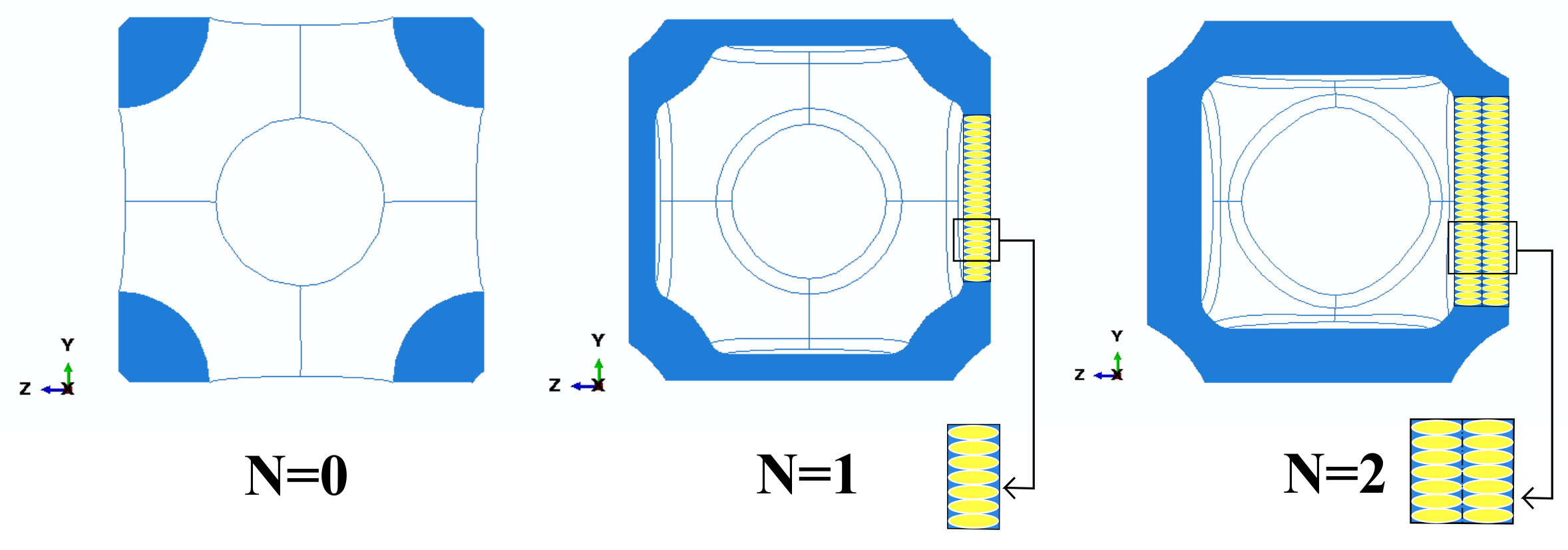
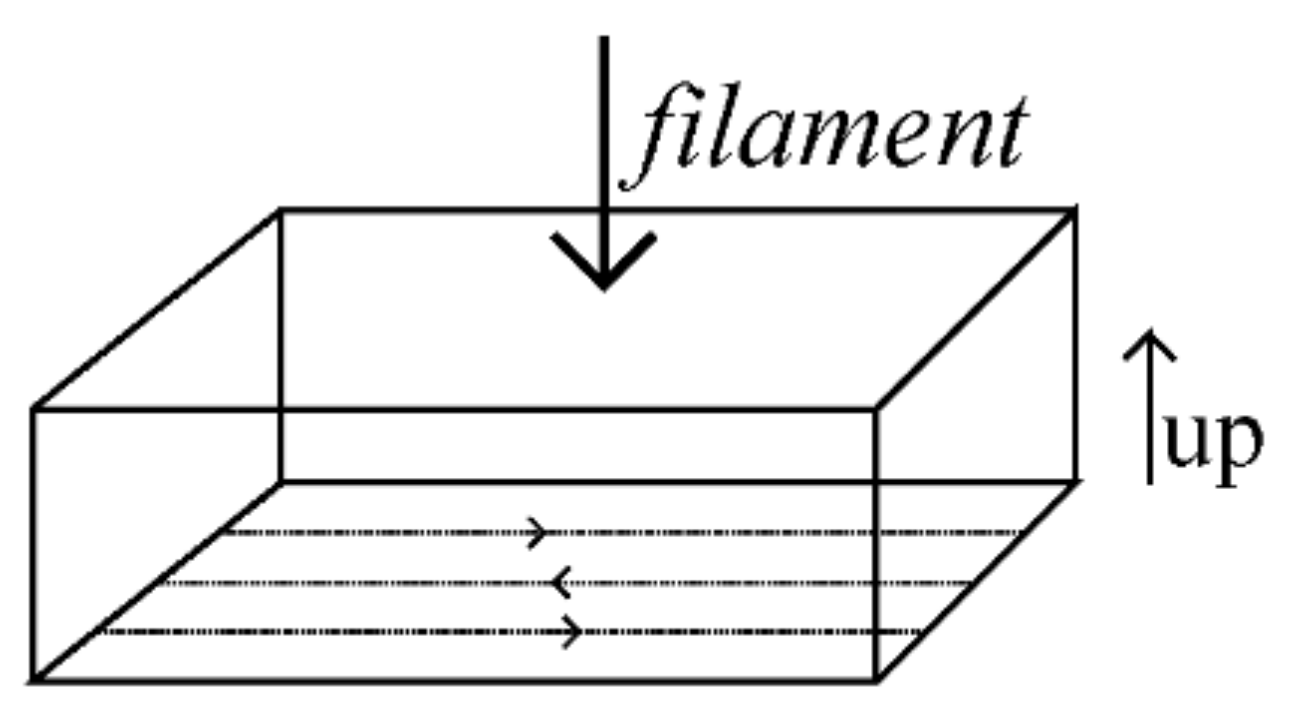
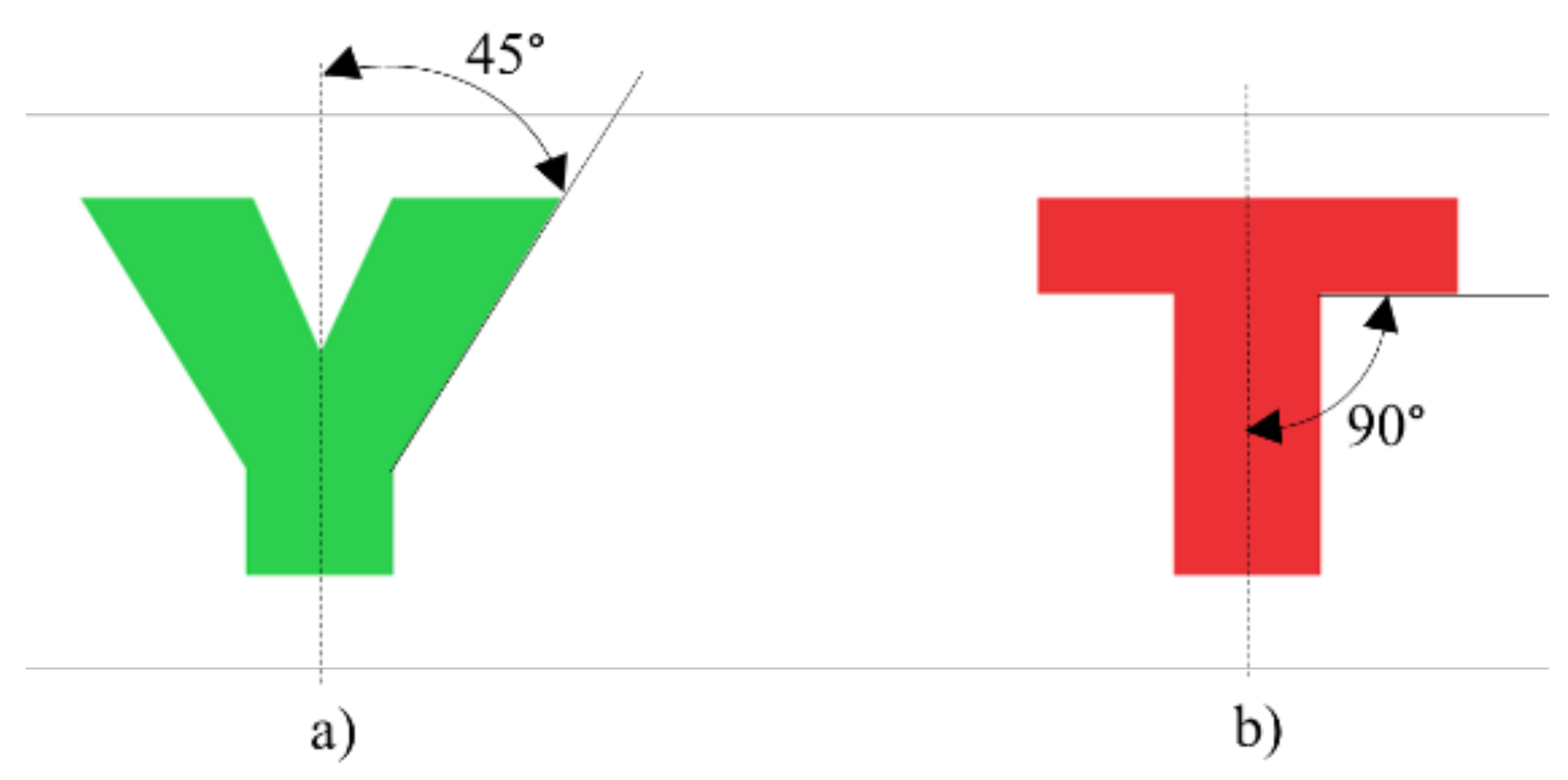
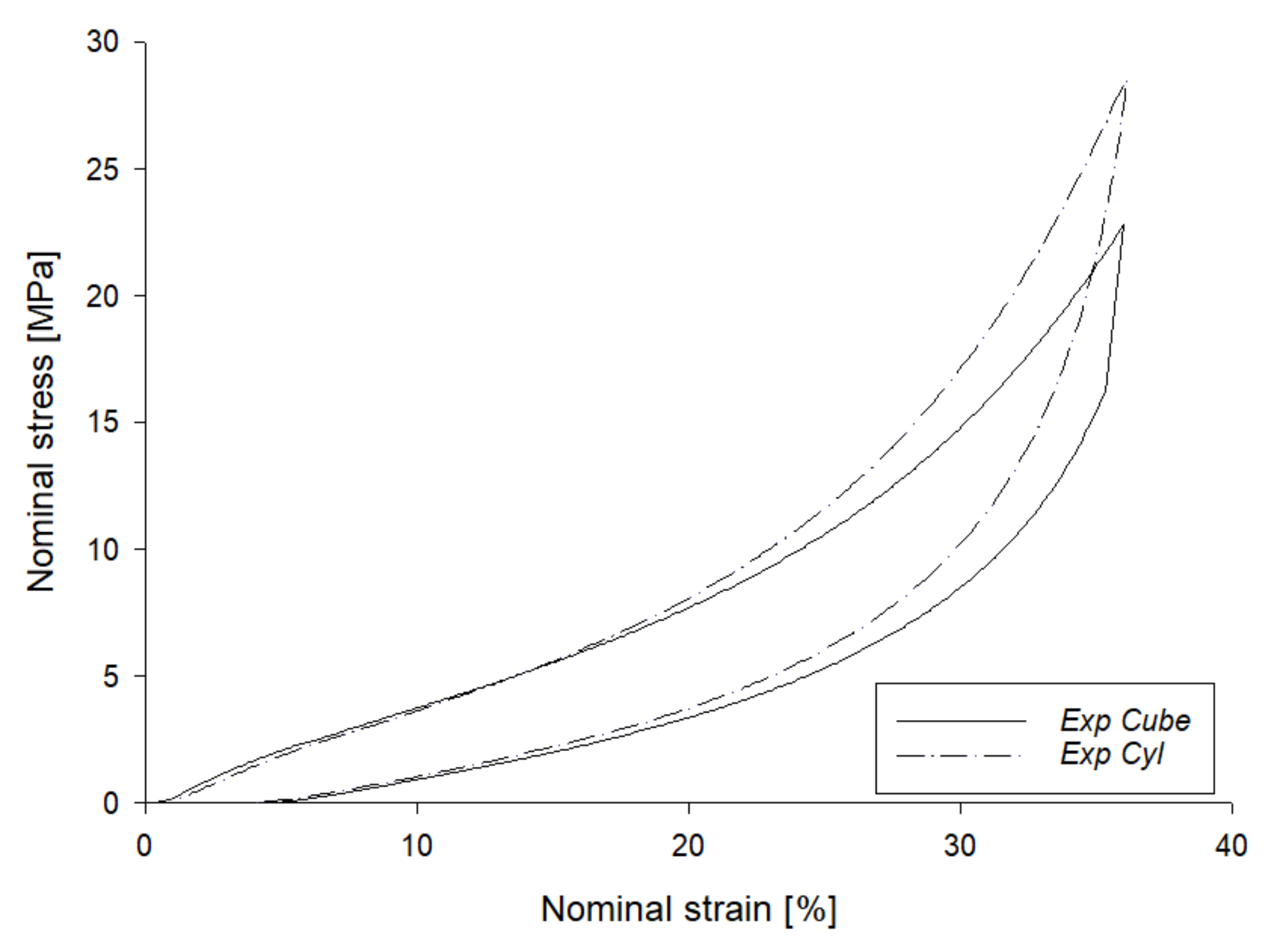

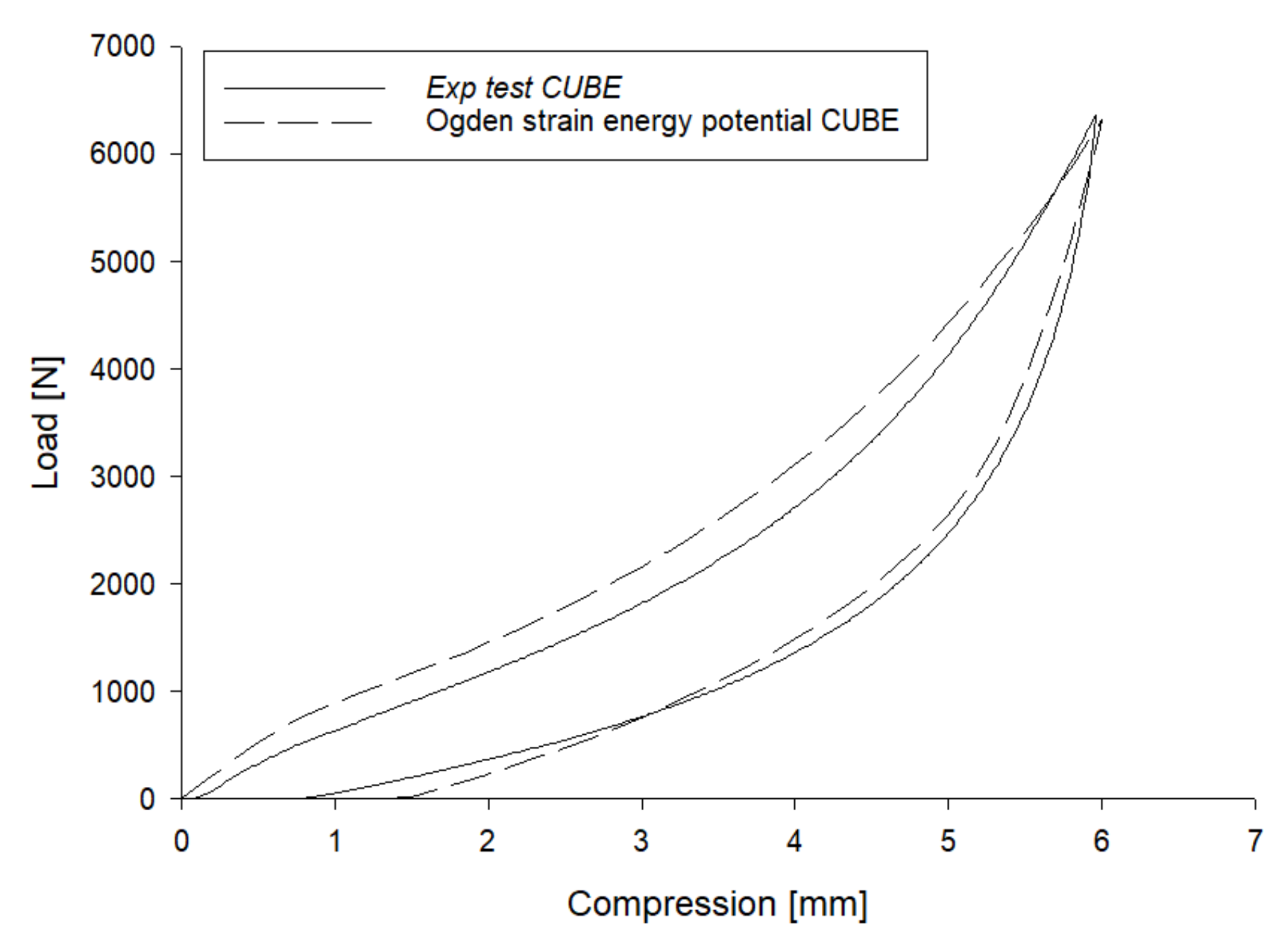
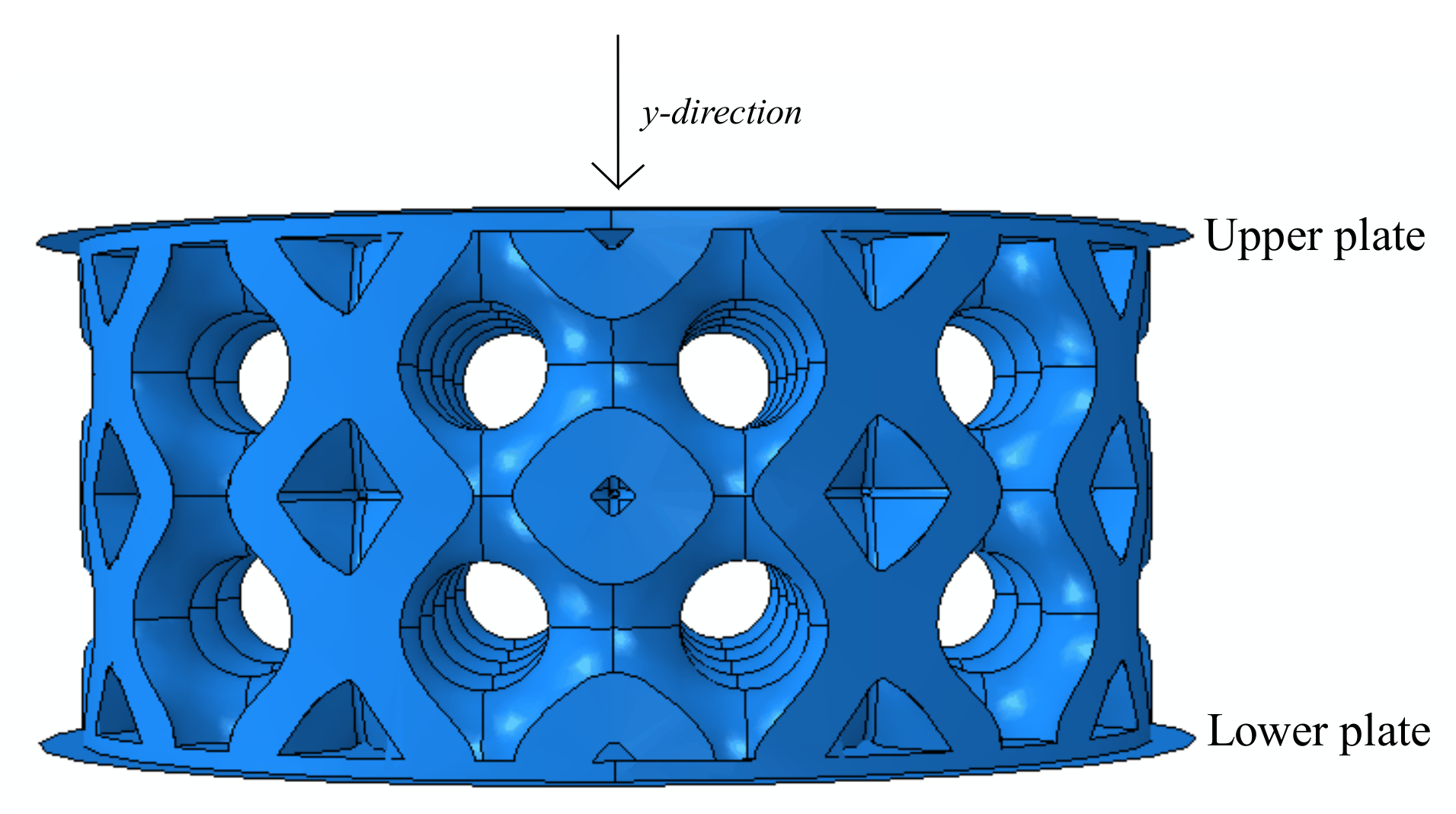


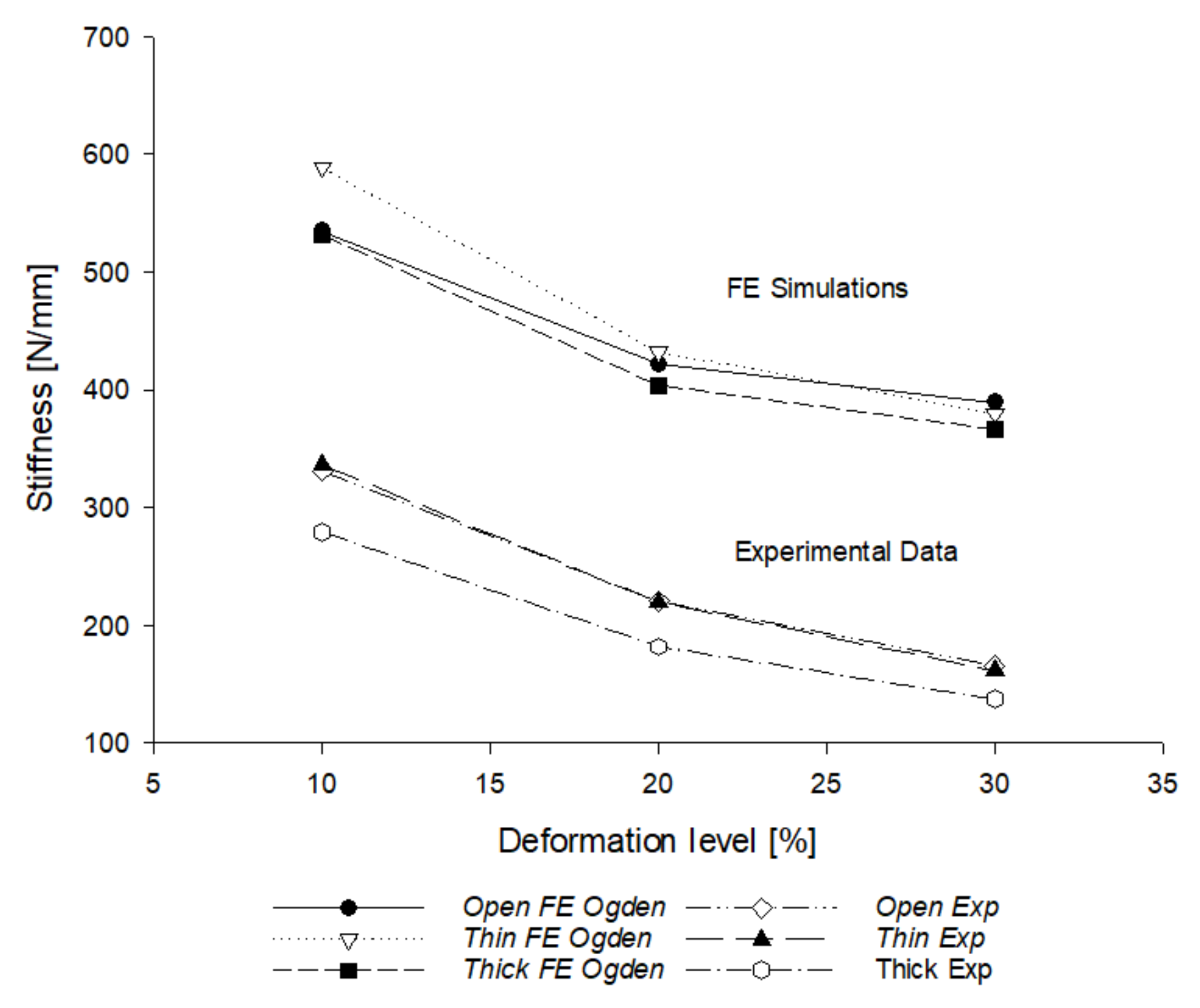
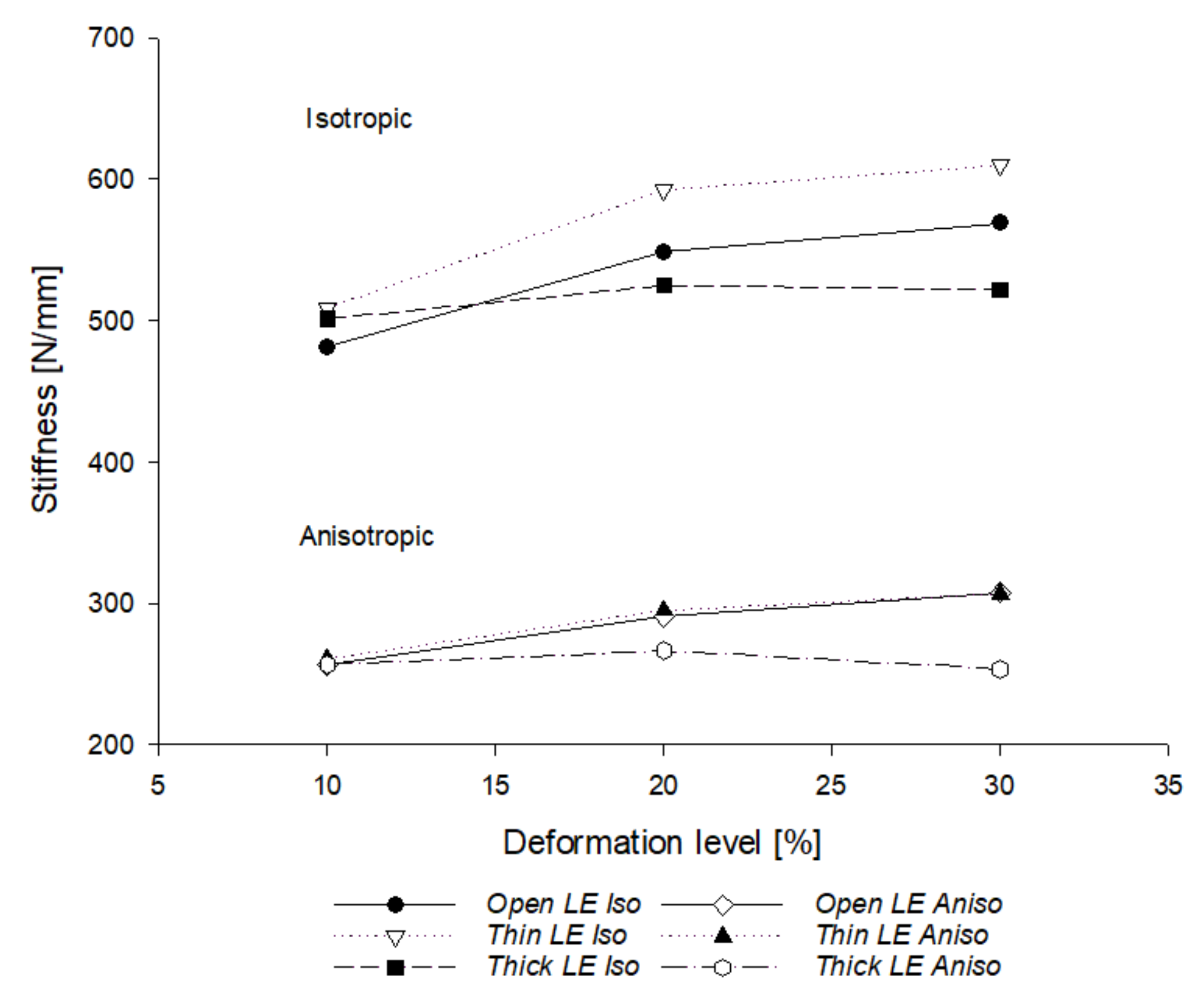

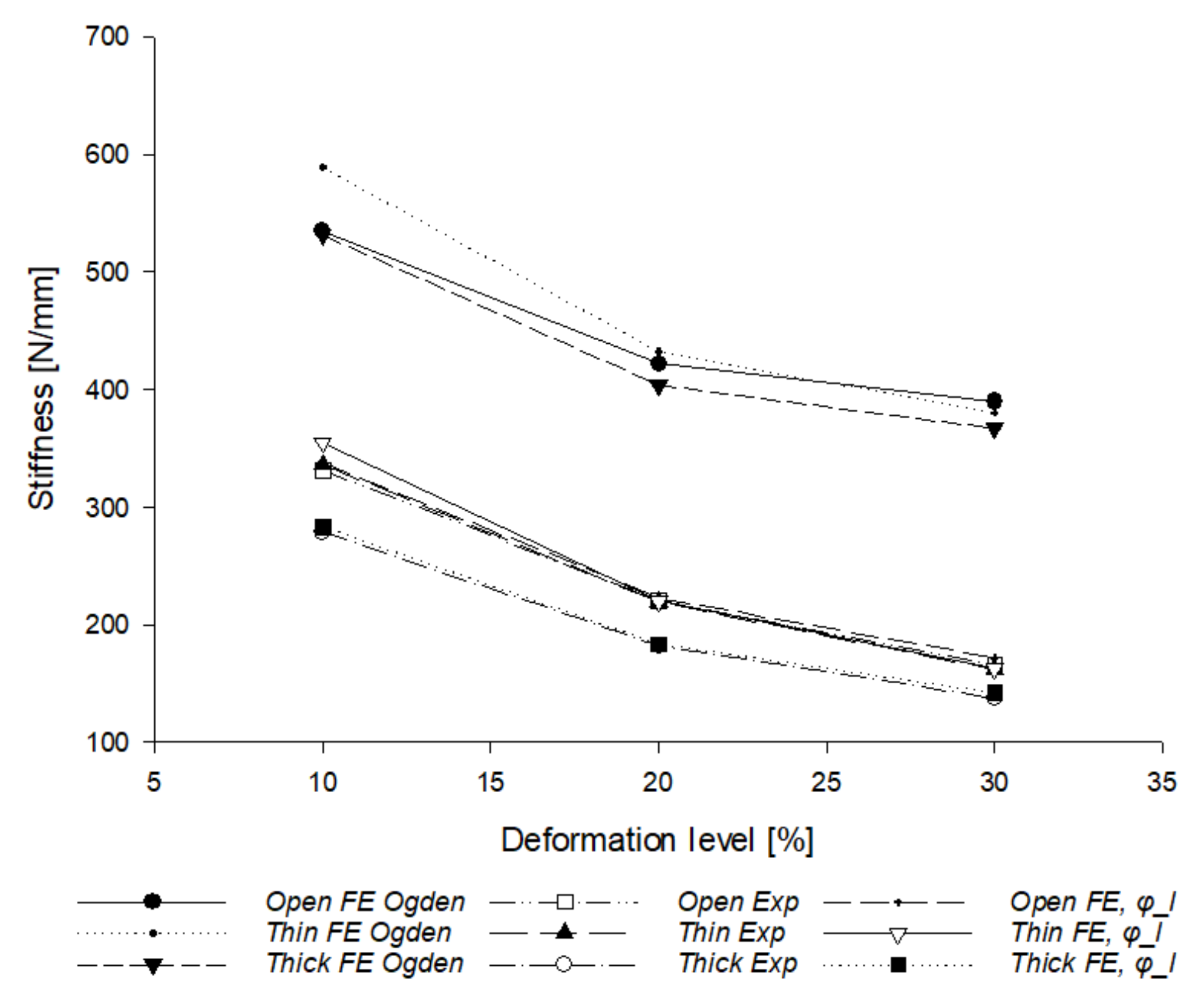

| Printing Phase: FDM Parameters | |
|---|---|
| Nozzle diameter [mm] | 0.4 |
| Layer height [mm] | 0.2 |
| Printing speed [mm/min] | 1100 |
| Print infill [%] | 100 |
| Printing temperature [°C] | 230 |
| Bed temperature [°C] | 70 |
| FDM Machine Parameters | |
| Minimum thickness [mm] | 0.6 |
| Maximum overhang angle [°] | 50 |
| Material Parameter | |||
|---|---|---|---|
| i = 2, order | 6.1298 | 0.0000 | −1.9004 |
| Parameter | S | m | C | A | E |
|---|---|---|---|---|---|
| value | 2.2 | 4 | 0 | 12 × 10−3 | 0.01 |
| Material | |||||||||
|---|---|---|---|---|---|---|---|---|---|
| Linear elastic | 13 | 26 | 13 | 0.49 | 0.39 | 0.49 | 4.36 | 9.35 | 4.36 |
| Topology | Nodes | Elements |
|---|---|---|
| Open cell | 24,779 | 104,274 |
| Closed thin-walled cell | 33,735 | 145,385 |
| Closed thick-walled cell | 37,790 | 157,045 |
| 10% | Stiffness K0 [N/mm] | |||
|---|---|---|---|---|
| EXP | FEM | |||
| Ogden | Isotropic LE | Anisotropic LE | ||
| Open cell | 331 | 534.6 | 480.8 | 256.4 |
| Closed thin walled | 336 | 588.8 | 508.7 | 260.7 |
| Closed thick walled | 278.9 | 531.2 | 500.8 | 256.3 |
| 20% | Stiffness K0 [N/mm] | |||
| EXP | FEM | |||
| Ogden | Isotropic LE | Anisotropic LE | ||
| Open | 220.3 | 421.7 | 548.1 | 290.2 |
| Closed thin walled | 219.2 | 432.2 | 592 | 294.8 |
| Closed thick walled | 181.9 | 403.8 | 524.6 | 266.2 |
| 30% | Stiffness K0 [N/mm] | |||
| EXP | FEM | |||
| Ogden | Isotropic LE | Anisotropic LE | ||
| Open | 165.5 | 389.6 | 568.4 | 307.7 |
| Closed thin walled | 161.7 | 380.1 | 609.5 | 306.6 |
| Closed thick walled | 137.5 | 366.7 | 521.6 | 253.3 |
Publisher’s Note: MDPI stays neutral with regard to jurisdictional claims in published maps and institutional affiliations. |
© 2021 by the authors. Licensee MDPI, Basel, Switzerland. This article is an open access article distributed under the terms and conditions of the Creative Commons Attribution (CC BY) license (https://creativecommons.org/licenses/by/4.0/).
Share and Cite
Ursini, C.; Collini, L. FDM Layering Deposition Effects on Mechanical Response of TPU Lattice Structures. Materials 2021, 14, 5645. https://doi.org/10.3390/ma14195645
Ursini C, Collini L. FDM Layering Deposition Effects on Mechanical Response of TPU Lattice Structures. Materials. 2021; 14(19):5645. https://doi.org/10.3390/ma14195645
Chicago/Turabian StyleUrsini, Chiara, and Luca Collini. 2021. "FDM Layering Deposition Effects on Mechanical Response of TPU Lattice Structures" Materials 14, no. 19: 5645. https://doi.org/10.3390/ma14195645
APA StyleUrsini, C., & Collini, L. (2021). FDM Layering Deposition Effects on Mechanical Response of TPU Lattice Structures. Materials, 14(19), 5645. https://doi.org/10.3390/ma14195645






